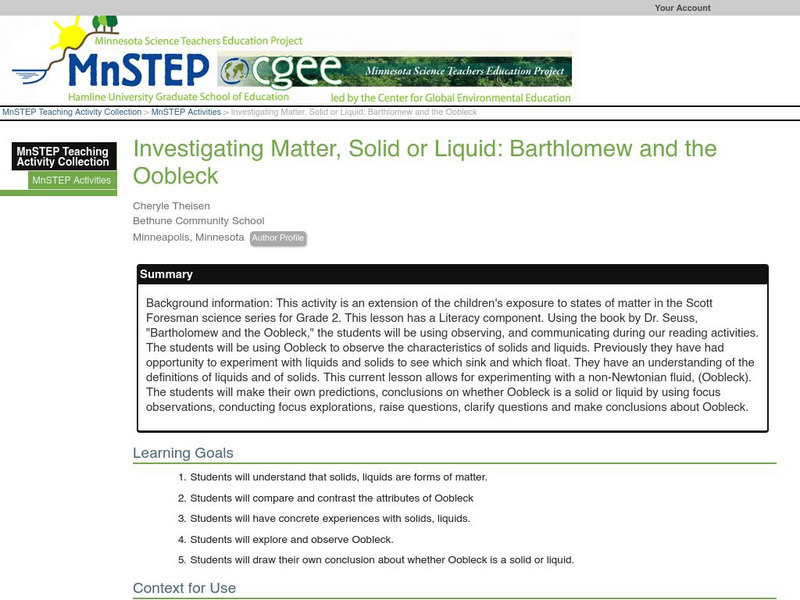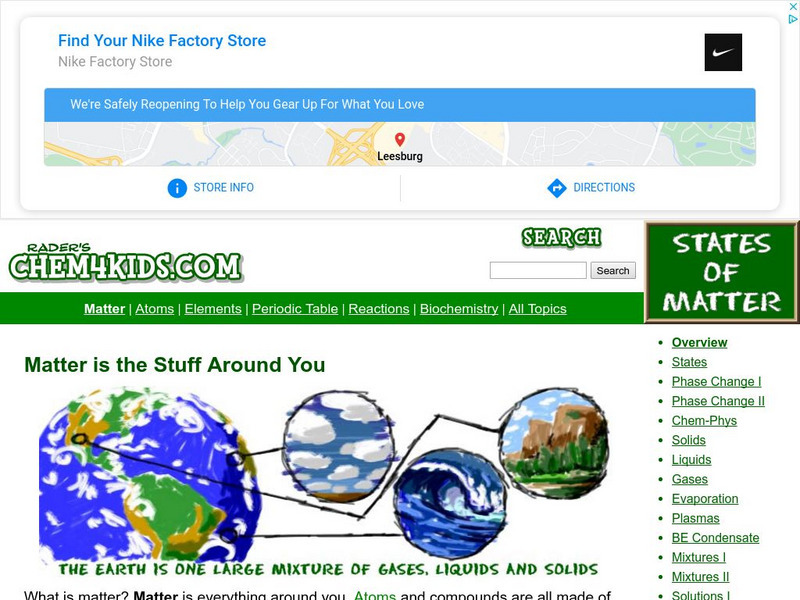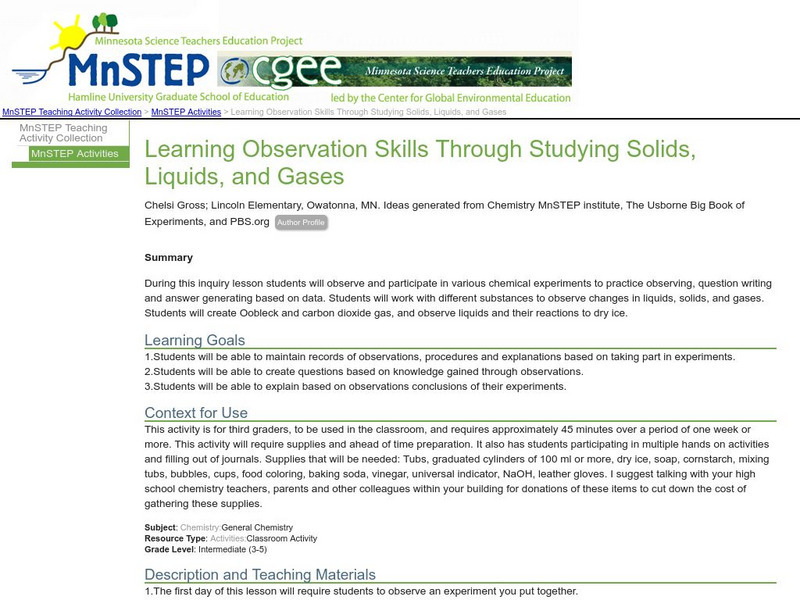The Association of the British Pharmaceutical Industry
Association of the British Pharmaceutical Industry: Solids, Liquids, and Gasses
A collection of cartoon animations that teach students what they need to understand about solids, liquids, and gases.
American Chemical Society
American Chemical Society: Science for Kids: Solids, Liquids and Gases
Engaging hands on science lessons for grades 2-6 on the three states of matter.
Science Education Resource Center at Carleton College
Serc: Investigating Matter, Solid or Liquid: Barthlomew and the Oobleck
Background information: This activity is an extension of the children's exposure to states of matter in the Scott Foresman science series for Grade 2. This activity has a Literacy component. Using the book by Dr. Seuss, "Bartholomew and...
American Chemical Society
Middle School Chemistry: Chapter 1: Solids, Liquids, and Gases
Five exemplary chemistry lessons about the three states of matter complete with handouts and animations.
PBS
Pbs Learning Media: States of Matter Fitness Lesson Plan
In this lesson plan, students use their science knowledge and apply it using physical activity! Learning about the stages of matter, solid, liquid and gas, students perform an exercise for each as the teacher calls out an object such as...
Concord Consortium
Concord Consortium: Stem Resources: States of Matter
Using simulations observe what solids, liquids, and gases look like at the atomic scale. After observing the different states of matter at their atomic level, students will be able to conclude about the forces and attractions that exist...
University Corporation for Atmospheric Research
Ucar: Just a Phase: Water as a Solid, Liquid, and Gas
This site helps students construct a model of the arrangement of water molecules when present as solid, liquid or gas. Includes background information, lesson plans, links to standards and assessment ideas.
Chiral Publishing
Chiral Publishing: An Introduction to Chemistry: Solids, Liquids, and Gases: Audio Book
An interactive guide to the basics of solids, liquids, and gases. Wonderful pictures show the makeup of each and how the particles move in these states of matter.
E-learning for Kids
E Learning for Kids: Norway Fjords: What Are Solids, Liquids and Gases?
The differences between solids, liquids, and gases and the properties of each are presented in this lesson.
CK-12 Foundation
Ck 12: Chemistry Simulation: States of Matter
[Free Registration/Login Required] Compare three states of matter: solid, liquid, and gas.
Chem4kids
Chem4 Kids: Matter
"Matter is everything." So begins this comprehensive website on the physical and chemical properties of matter in its four main states: solids, liquids, gases, and plasmas. The text is large and easy-to-read. Students will enjoy the...
Utah Education Network
Uen: Liquid Exploration
Observe the differences between solids, liquids and gases.
Ducksters
Ducksters: Kids Science: Solid, Liquid, Gas
Kid's learn about the science of states of matter. Solids, liquids, gases, and even plasma.
University of Colorado
University of Colorado: Ph Et Interactive Simulations: States of Matter
Watch different types of molecules form a solid, liquid, or gas. Add or remove heat and watch the phase change. Change the temperature or volume of a container and see a pressure-temperature diagram respond in real time. Relate the...
University of Colorado
University of Colorado: Ph Et Interactive Simulations: University of Colorado: States of Matter: Basics
An interactive simulation will heat, cool and compress atoms and molecules. Watch as they change between solid, liquid and gas phases. Recognize that different substances have different properties which will affect the temperatures for...
University of Colorado
University of Colorado: Ph Et Interactive Simulations: States of Matter: Basics
After watching this simulation, students will be able to describe characteristics of the three states of matter. They will watch as atoms and molecules change between solid, liquid and gas phases.
CK-12 Foundation
Ck 12: Fifth Grade Science: Physical Science: Solids, Liquids, and Gases
[Free Registration/Login may be required to access all resource tools.] Explains how to describe matter in the solid state, about the properties of liquid matter and gases, and what the relationship between energy and states of matter is.
Science Education Resource Center at Carleton College
Serc: Learning Observation Skills Through Studying Solids, Liquids, and Gases
During this lesson, students will practice observing, question writing, and answer generating based on taking part in experiments. Students will work with different substances to observe changes in liquids, solids, and gases.
PBS
Pbs Learning Media: Mystery Mud: Exploring Changes in States of Matter
Join a group of middle-school students on a visit to a laboratory at the Massachusetts Institute of Technology, where they experiment with "mystery mud" and learn about the relationships between magnetism, particle motion, and changes in...
Vision Learning
Vision Learning: Three States of Matter
Concept animation compares molecular movement of solids, liquids, and gases.
Georgia Department of Education
Ga Virtual Learning: Physical Science: Matter and the Atom
Students investigate the structure and parts of the atom, and learn about atomic mass and atomic number. They also explore the differences among solids, liquids, gases, and plasma.
CK-12 Foundation
Ck 12: Properties of Matter
[Free Registration/Login may be required to access all resource tools.] In this learning module, students examine differences in physical and chemical properties of solids, liquids, and gases.
ClassFlow
Class Flow: Solid, Liquid or Gas
[Free Registration/Login Required] This flipchart gives a flowchart depicting the states of matter-solid, liquid and gas. Students are asked to complete a chart placing various items into these categories.
ABCya
Ab Cya: States of Matter
States of Matter is an educational activity for kids to learn about the different properties of matter. The lesson will introduce solids, liquids, and gases. Students will then be assessed through a sorting activity where they will...


















